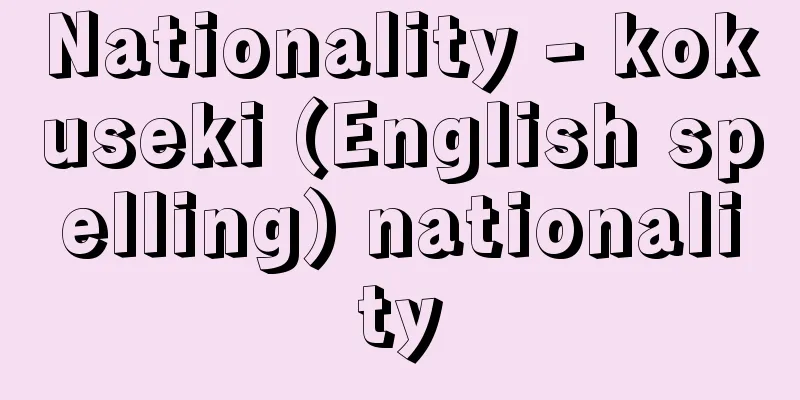Tokuyama Domain

|
One of the branch domains of the Mori clan of the Choshu Domain (Yamaguchi). It held 24 villages in Tsuno District, one village in Kumage District, one village in Saba District, and two villages in Abu District, Nagato Province (northwestern Yamaguchi Prefecture). Its founder was Mori Terumoto's second son, Naritaka, and in 1617 (Genwa 3), it was granted 30,000 koku of rice, and in 1634 (Kanei 11), it was listed as a feudal lord by the shogunate (Kudamatsu Domain). Naritaka first established his residence in Kudamatsu, Tsuno District, but moved to Nogami, Tsuno District, for convenient transportation, developed a castle town, and changed the place name to Tokuyama in 1650 (Keian 3). It came to be called Tokuyama Domain. The Kan'ei land survey gave the clan's stipend at 40,010 koku, but the So clan reported 45,000 koku to the shogunate, and this became the official stipend. In 1716 (Kyoho 1), during the reign of the third lord, Mototsugu, a rift arose between the clan and the So clan over a complicated border dispute, which eventually led to the dissolution of the Tokuyama clan. Mototsugu's territory was confiscated by the So clan and he was entrusted to the Shinjo clan in Dewa Province (Shinjo City, Yamagata Prefecture). The clan was allowed to be restored in 1719, and his eldest son, Mototaka, was given a new stipend of 30,000 koku. Later, in 1836 (Tenpo 7), the shogunate recognized him as a castle lord, with an additional stipend of 10,010 koku. One of the main industries was papermaking, with the mountain village of Suma and five other villages (Omukai, Odori, Kawamagari, Shikuma, and Kamimura) in the main production areas. The clan adopted a paper-submission system, in which paper was paid as annual tax, and also worked to protect and nurture it. Salt fields also developed on the Seto Inland Sea side, and along with paper, it was a major industry. The successive feudal lords were Jutaka, Motokata, Mototsugu, Mototaka, Hirotoyo, Hirotomo, Takayoshi, Hiroshige, and Motomitsu. Hiroshige's son Motonori took over as head of the clan, and in 1871 (Meiji 4), prior to the abolition of the clan, the clan was merged into the Choshu clan. [Kazuo Yoshimoto] [Reference] |Source: Shogakukan Encyclopedia Nipponica About Encyclopedia Nipponica Information | Legend |
|
長州藩(山口)毛利(もうり)氏の支藩の一つ。周防(すおう)国(山口県南東部)都濃(つの)郡24か村、熊毛(くまげ)郡1か村、佐波(さば)郡1か村、長門(ながと)国(山口県北西部)阿武(あぶ)郡2か村を領有した。毛利輝元(てるもと)の二男就隆(なりたか)を祖とし、1617年(元和3)に3万石の分与を受け、34年(寛永11)に幕府によって諸侯に列せられた(下松(くだまつ)藩)。就隆は最初、都濃郡下松に居館を構えたが、交通の便から同郡野上(のがみ)に移って城下町を整備するとともに、1650年(慶安3)に地名を徳山と改めた。以降徳山藩を称するようになった。知行高(ちぎょうだか)は寛永(かんえい)検地で4万0010石となったが、宗(そう)藩から幕府への届出は4万5000石となり、これが公称高となった。3代元次(もとつぐ)の1716年(享保1)には、境界のもつれから宗藩との間に不和を生じ、ついには徳山藩の断絶にまで発展し、領地の宗藩への没収とともに、元次は出羽(でわ)国新庄(しんじょう)藩(山形県新庄市)へ預けられた。藩の再興が許されたのは1719年で、嫡子元堯(もとたか)に改めて3万石が分与された。その後、1836年(天保7)に1万0010石の加増をもって城主格の待遇を幕府から認知された。 産業としては造紙業があり、山間部の須万(すま)村と5か村(大向(おおむかい)、大道理(おおどうり)、川曲(かわまがり)、四熊(しくま)、上村(かみむら))を主要産地とし、年貢に紙を納める請紙(うけがみ)制を採用するとともに、その保護育成に努めた。瀬戸内側では塩田も発達し、紙とともに主要な産業であった。歴代藩主は、就隆、元賢(もとかた)、元次、元堯、広豊(ひろとよ)、広寛(ひろとも)、就馴(たかよし)、広鎮(ひろしげ)、元蕃(もとみつ)。広鎮の子元徳(もとのり)が宗藩を継いだこともあって、廃藩に先だち1871年(明治4)長州藩に合併した。 [吉本一雄] [参照項目] |出典 小学館 日本大百科全書(ニッポニカ)日本大百科全書(ニッポニカ)について 情報 | 凡例 |
Recommend
Matadi - Matadi (English spelling)
A city in the western part of the Democratic Repu...
Sedum morganianum (English spelling)
… [Hiroshi Yuasa]. … *Some of the terminology tha...
Amiaosa - Amiaosa
...There are many species, and about 10 species g...
Tawara Shonin
?-1600 A military commander from the Sengoku to O...
Mandala Temple
This Seizan Jodo sect temple is located in Maehib...
Carbuncle
A summoned beast that appears in the role-playing ...
Sariwon - Sariin
A city in the western part of North Hwanghae Prov...
The Viviparous Quadrupeds of North America
...This is famous for its detailed depictions of ...
Pterois volitans (English spelling) Pteroisvolitans
...As it grows, the front half of its body turns ...
Liberalism (English spelling)
Liberalism is a political, economic, and social i...
Agglutination reaction
An antigen-antibody reaction. When cellular antige...
bilateral descent
…Some researchers define the type of social proce...
Salis, R. (English spelling) SalisR
...It is a bar with a stage and a dance hall for ...
Myouchi ware - Myouchi ware
The largest fire in Osaka in the early modern peri...
Christian version - Kirishitanban
This refers to books and publications (Katsusa ed...









